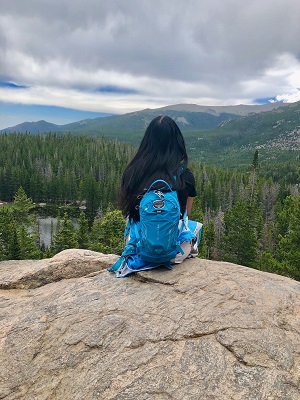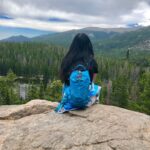
In case the plan for the future farm with miniature horses, the summer I spent working at an equestrian center, and the fact that my eyes light up like decked out Christmas trees whenever I see horses aren’t dead giveaways, lemme just mention that I happen to love horses. (Just so we’re on the same page.)
Way back in the day (last semester), I made a post about Spring Reins of Hope, which I discovered through my Behavioral Science professor. I was more than a little intrigued by their Horse for Healers course, but also completely devastated when I found out it would take place in late March/early April, because this meant that my last class (Immunology/Microbiology) would have started by then. I had to miss the first shadowing day due to an embryology exam that I didn’t manage to move, but I did indeed find a way to get there!
F: I’m sorry I couldn’t be here last week! I had an exam last week, but I’m so so happy to be here today!
: You’re so cute.
(._. clearly, i could not contain my excitement.)
I was surprised to find out that it’s the west coast that pioneered equine-related therapy and training. Leave it to me to find this out while I’m on the east coast, at the only equine-assisted therapy facility on this side of the country.
Although I missed the first shadowing day, I got to wade right in on the second (and last) day at the center. We started off with breakfast and talked a little bit about nonverbal communication and the importance of body language, as well as how horses acted in herds. Then we moved off to meet Straw and OJ, our “patients” for the exercise. We split off into two groups and took our “patient” to various stations to work with them. For this, we were mainly paying attention to how our horse responded to the different things at each station (which included anything from brushes to bell boots).

Our group worked with OJ, so here’s OJ with the fly mask we put on him. He had a huge crush on Straw and wouldn’t cooperate unless he could look at her.
Then we went through another exercise where we had to send a different horse (Syri) away using just body language. I felt pretty bad about this because we’d just learned about how the lead mare would send a horse away if s/he’d done something wrong, but Syri hadn’t done anything, and got sent away by us for no apparent reason 9 times. :[ (My method was basically just walking at her at a very swift pace.) We were given a demonstration on how two different approaches yielded completely different responses, and it brought to light about how much your mindset really matters when you’re working with someone. (This is something I’ve never actually stopped to think about.)
On particularly busy days when I was volunteering at clinic back in Sacramento, I recall consciously telling myself to slow down before I walked into the room. Sure, there might be 50 people waiting, but right then and there, it was the patient I was working with who was the most important. So despite the fact that I’d just performed several Matrix-style maneuvers at breakneck speeds (I walk pretty quickly) to get to the room in one piece with the forms or equipment that the patient needed, I’d take a breath and slow down before walking in. One tiny change, monumental difference.
The same worked for the horses. If you walked straight at Syri without looking at her, without acknowledging or thinking about her, and while holding your breath, she would freak the hell out and bolt, because there’s something seriously wrong if you’re making a beeline toward someone with total disregard to how s/he might be feeling. On the flip side, if you approached in a less direct (and thus, less threatening) manner while looking at her and continuing to breathe, she’d stay still and let you come by to do your thing.
Our next exercise involved drawing pieces of paper out of a hat. I drew the first one, which was to braid a section of her mane. There were others that involved brushing her, offering her water, getting her to follow you, touching her face, etc. Then we took a break for lunch, which I mainly spent hanging out with this cat and this horse because they were super cute.

Apparently, this majestic cat’s name is Buster. He loves attention.

I don’t know this one’s name, but he kept licking my hand because I’d eaten an apple with it. He also tried to eat my jacket.
After lunch, we played equine billiards, where the objective was to herd three horses into one of four “pockets” that we’d created. We were given hula hoops and noodles as optional props, but after the first couple people, we decided to start resorting to our own articles of clothing. In the first round, we were each given 1 minute and the people standing in line weren’t allowed to speak. After discovering that most of the minute was spent traveling to the horse, we were told that our line was fine as long as we stayed within the cones, so we implemented a moving line for the remainder of the rounds. In the second, we were given a minute and the person wasn’t allowed to speak or to touch the horse, but the people in line could. In the third, we had 30 seconds, weren’t allowed to touch the horse, and no one was allowed to speak.
We definitely very quickly learned how to communicate with each other through body language, hand motions–even just by through eye contact and looking at one another. We also utilized our line to corral the last horse and deter him from running to the opposite side of the field. Teamwork. Hells yes. It made a world of a difference, and we got through all three rounds much faster than they thought we would, so much so that they decided to set up an obstacle course for us since we had a spare hour.

Cosmo!
All 9 humans and all 3 horses had to pass through the obstacle course linked together in some way. (If anyone knocked anything over in the obstacle course, we’d have to start over.) We split into groups of three and each chose a horse to corral. Whe we had them all in roughly the same place, we joined hands/manes/horse butts and walked through. I think it took us 12 minutes out of our spare hour, so we did an exercise to see how our personal bubbles were, starting from standing uncomfortably close to someone and taking steps backwards until it felt like a comfortable distance. (For most people, it was around 2-3 feet, except with the two pairs who lived with each other.)
At around 4, we had to head out, so we put halters on the horses and led them back. I so miss working at the equestrian center. ;_; I kinda feel like somewhere in the future, I may want to live on a farm, or somewhere where I can always go hang out with and ride horses whenever I have time. ._.
It was truly a fun and unique experience that I think all of us really learned a lot from. (I think most people don’t realize just how much their body language affects their interactions with other people.) It doesn’t matter whether or not you’ve had previous experience working with the horses either. I just wish there could’ve been more shadowing days, because there was a lot more we could have learned (and of course, I jump at any and every opportunity to hang out with horses). I am sending my best of wishes towards this program. :] It’s definitely my hope that this course will launch off and become a required part of the curriculum at this + other medical school campuses.

My butt and this horse (Cosmo) share the same name. :]
Possibly more pictures to come in a later post, when they’ve been uploaded/I’ve leeched them from facebook. There is apparently a 30-minute video out there that features the course and has snippets of the 9 of us talking, which I’m slightly afraid of seeing because I am all sorts of awkward behind a camera. (This is one of about a billion reasons as to why I could/should never be famous.)




















![One of my childhood dreams was to get to take horseback riding lessons, but as that was/is quiteeee expensive, I had to keep my dreams in check. While I was at UCD, I got to volunteer at the equestrian center each week (something I’d have happily done for free) in exchange for riding lessons. ❤️ That summer’s memories remain as some of the happiest ones in my life. 🥰
After I finished residency, @successlifegoals (my super cool brother!) helped me to refinance my monstrous student loans into something way more feasible and I’ve been super aggressively paying them off ever since. As of the end of this month, I will be doneeeeeee!!! So naturally, my treat to self = horseback riding lessons! 😊🤩✨
I had my introductory lesson over the weekend and I miraculously have not forgotten absolutely everything. :]
This is Phoenix! He is a cute lazy boi who likes naps + pretending his feet are cement and that he cannot possibly move them, but thankfully he still listens. 🤣❤️](https://www.fairyburger.com/wp-content/plugins/instagram-feed/img/placeholder.png)






1 pings
[…] Horses for Healers […]